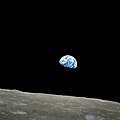Fitxer:NASA Earthrise AS08-14-2383 Apollo 8 1968-12-24.jpg

Mida d'aquesta previsualització: 598 × 599 píxels. Altres resolucions: 240 × 240 píxels | 479 × 480 píxels | 767 × 768 píxels | 1.022 × 1.024 píxels | 2.044 × 2.048 píxels | 4.158 × 4.166 píxels.
Fitxer original (4.158 × 4.166 píxels, mida del fitxer: 2,87 Mo, tipus MIME: image/jpeg)
| Aquest fitxer i la informació mostrada a continuació provenen del dipòsit multimèdia lliure Wikimedia Commons. |
Resum
| William Anders: Earthrise
|
|||||||||||||||||||||||||||
|---|---|---|---|---|---|---|---|---|---|---|---|---|---|---|---|---|---|---|---|---|---|---|---|---|---|---|---|
| Autor |
NASA/Bill Anders |
||||||||||||||||||||||||||
| Fotògraf |
|
||||||||||||||||||||||||||
| Títol |
Earthrise label QS:Len,"Earthrise"
label QS:Lar,"شُرُوقُ الأرض"
label QS:Lbe-tarask,"Узыход Зямлі" |
||||||||||||||||||||||||||
| Object type |
fotografia |
||||||||||||||||||||||||||
| Descripció |
Беларуская (тарашкевіца): Фатаздымак, зроблены астранаўтам «Апалёну-8» Білам Андэрзам ранкам 24 сьнежня 1968 року а 075:49:07 з пачатку палёту [1] (16:40 UTC), на арбіце вакол Месяца, паказвае трэці ўзыход Зямлі над месячным гарызонтам. Месячны гарызонт знаходзіцца прыкладна за 570 км ад касьмічнага карабля. Шырыня сфатаграфаванага абшару на месячным гарызонце — каля 150 км [2]. Кавалак зямлі, бачны адразу над лініяй сьветападзелу — заходняя Афрыка. Такі эфэкт бачны толькі такому назіральніку, які знаходзіцца ў руху адносна паверхні Месяцу, бо Месяц круціцца сынхронна адносна Зямлі (Месяц заўсёды павернуты да Зямлі адным бокам), і з-за гэтага Зямля на месячным «небе» падаецца нерухомай (ня ўлічваючы часавага прасьцягу геалягічных маштабаў). Каб убачыць эфэкт узыходу ці заходу Зямлі над месячным гарызонтам, назіральнік мусіць перамясьціцца ўперад ці ўзад ад кропкі на паверхні Месяцу, дзе Зямля знаходзіцца над самай галавой (па цэнтры неба). Іначай бачны рух/зьмена становішча Зямлі будзе абмежаваная: 1. Павелічэньнем/памяншэньнем памеру пры зьмяненьні адлегласьці між двума нябёснымі целамі. 2. Драбнюткім заўважным зьмяшчэньнем Зямлі з прычыны эксцэнтрысытэту арбіты Месяцу — эфэкту пад назвай «хістаньне». 3. Кручэньнем Зямлі (кручэньне Месяцу сынхроннае адносна Зямлі, а кручэньне Зямлі не сынхроннае адносна Месяцу). 4. Атмасфэрным і паверхневым зьмяненьнямі на Зямлі (напрыклад: мадэлямі надвор’я, зьмяненьнем пораў году й інш.). Двум кратэрам, бачным на здымку, Міжнародны астранамічны зьвяз у 2018 року прысвоіў найменьні 8 Homeward і Anders' Earthrise у гонар місіі «Апалёну-8»[3]. English: Taken by Apollo 8 crewmember Bill Anders on the morning of December 24, 1968, at mission time 075:49:07 [4] (16:40 UTC), while in orbit around the Moon, showing the Earth rising for the third time above the lunar horizon. The lunar horizon is approximately 570 kilometers (350 statute miles) from the spacecraft. Width of the photographed area at the lunar horizon is about 150 kilometers (95 statute miles). [5] The land mass visible just above the sunset terminator line is west Africa. Note that this phenomenon is only visible to an observer in motion relative to the lunar surface. Because of the Moon's synchronous rotation relative to the Earth (i.e., the same side of the Moon is always facing Earth), the Earth appears to be stationary (measured in anything less than a geological timescale) in the lunar "sky". In order to observe the effect of Earth rising or setting over the Moon's horizon, an observer must travel towards or away from the point on the lunar surface where the Earth is most directly overhead (centered in the sky). Otherwise, the Earth's apparent motion/visible change will be limited to: 1. Growing larger/smaller as the orbital distance between the two bodies changes. 2. Slight apparent movement of the Earth due to the eccenticity of the Moon's orbit, the effect being called libration. 3. Rotation of the Earth (the Moon's rotation is synchronous relative to the Earth, the Earth's rotation is not synchronous relative to the Moon). 4. Atmospheric & surface changes on Earth (i.e.: weather patterns, changing seasons, etc.). Two craters, visible on the image were named 8 Homeward and Anders' Earthrise in honor of Apollo 8 by IAU in 2018.[6] |
||||||||||||||||||||||||||
| Data | Taken on 24 de desembre de 1968, 16:40 UTC[7] | ||||||||||||||||||||||||||
| Col·lecció |
institution QS:P195,Q23548
|
||||||||||||||||||||||||||
| Notes |
Taken on 70-mm Ektachrome film magazine with modified Hasselblad 500EL camera (pictured below) and lens with 250-mm focal length. Exposure time is 1/250 of a second, focus setting is f/11. [8] Lunar coordinates are 110 km (68 miles, 60 nautical miles) above 11.2°S 113.8°E. [9] |
||||||||||||||||||||||||||
| Referències |
100 Photographs: The Most Influential Images of All Time |
||||||||||||||||||||||||||
| Font |
|
||||||||||||||||||||||||||
| Permís (Com reutilitzar aquest fitxer) |
|
||||||||||||||||||||||||||
| Altres versions |
|
||||||||||||||||||||||||||
Aquest fitxer ha estat catalogat per Johnson Space Center dels Estats Units d'Amèrica per a l'Administració Nacional d'Aeronàutica i de l'Espai (NASA)en virtut identificat com a: ID del fitxer : AS08-14-2383.Els ID dels fitxers i ID alternatius són traduïts de Photo ID .Aquesta etiqueta no indica l'estat dels drets d'autor de la imatge carregada. Cal un senyal de drets d'autor. Vegeu Commons:Sobre les llicències. Altres idiomes:
العربية ∙ беларуская (тарашкевіца) ∙ български ∙ català ∙ čeština ∙ dansk ∙ Deutsch ∙ English ∙ español ∙ فارسی ∙ français ∙ galego ∙ magyar ∙ հայերեն ∙ Bahasa Indonesia ∙ italiano ∙ 日本語 ∙ македонски ∙ മലയാളം ∙ Nederlands ∙ polski ∙ português ∙ русский ∙ sicilianu ∙ slovenščina ∙ Türkçe ∙ українська ∙ 简体中文 ∙ 繁體中文 ∙ +/− |
Llicència
| Public domainPublic domainfalsefalse |
| Aquest fitxer és en el domini públic perquè ha estat creat per la NASA. L'avís legal de la NASA diu que «el material de la NASA no està protegit per copyright si no es diu el contrari». (NASA copyright policy page o JPL Image Use Policy). |  | |
 |
Atenció:
|
Llegendes
Afegeix una explicació d'una línia del que representa aquest fitxer
Earth, as photographed by Bill Anders 110 km above the lunar surface, on 24 December 1968 during Apollo 8
Elements representats en aquest fitxer
representa l'entitat
24 des 1968
Historial del fitxer
Cliqueu una data/hora per veure el fitxer tal com era aleshores.
| Data/hora | Miniatura | Dimensions | Usuari/a | Comentari | |
|---|---|---|---|---|---|
| actual | 04:04, 23 abr 2019 |  | 4.158 × 4.166 (2,87 Mo) | Earthsound | User created page with UploadWizard |
Ús del fitxer
La pàgina següent utilitza aquest fitxer:
Ús global del fitxer
Utilització d'aquest fitxer en altres wikis:
- Utilització a ar.wikipedia.org
- Utilització a be-tarask.wikipedia.org
- Utilització a da.wikipedia.org
- Utilització a en.wikipedia.org
- Utilització a en.wikiquote.org
- Utilització a fa.wikipedia.org
- Utilització a simple.wikipedia.org
- Utilització a www.wikidata.org




